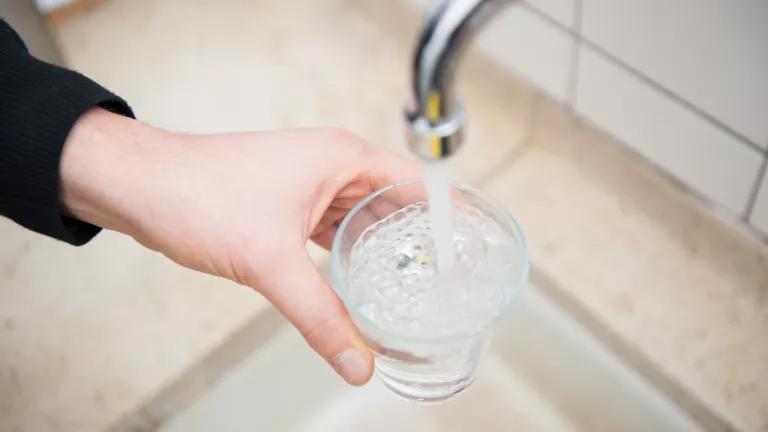Report: Getting the Lead Out Costs Less Than You May Think
Don’t Let Opponents’ Overblown Cost Estimates Derail EPA Rules to Replace Toxic Lead Pipes

Copper pipe replacing lead service lines in Flint, MI
Angela Guyadeen, NRDC
One of the Biden Administration’s signature environmental initiatives—getting the lead out of drinking water—took an important step forward recently.
On August 1, the Environmental Protection Agency submitted its proposed Lead and Copper Rule Improvements (LCRI) to the White House for final review. The draft rule now sits at the Office of Management and Budget’s (OMB) Office of Information and Regulatory Affairs (OIRA).
This critical White House office is the last stop before EPA can require all water utilities to replace the toxic lead pipes that deliver water to millions of people. EPA received hundreds of thousands of comments—the most ever for a safe drinking water rule—in support of this initiative.
But many water utilities have been pushing EPA—and are now pushing the White House—to water down the rule. One of the loudest voices has been the American Water Works Association (AWWA), which lobbies on utilities’ behalf in Washington. In fact, AWWA met with OMB this month to make their pitch.
When EPA proposed the rule last year, AWWA expressed support for the idea of replacing all lead service lines. But they opposed EPA’s proposal to require utilities to replace all of these pipes. Why? Their chief complaint always seems to be the cost.
AWWA claims that the cost of replacing a lead service line far exceeds EPA’s estimated cost. They rely on a 2022 study they commissioned, which examined cost data from selected cities.
So, NRDC commissioned an independent review of AWWA’s cost study, by Safe Water Engineering. It turns out that AWWA’s cost estimates are vastly exaggerated. Conversely, EPA’s cost estimates are consistent with the costs of lead service line replacement projects around the country, and with typical labor and materials costs used in the construction industry.
We provided the Safe Water Engineering report to EPA in February 2024, along with our comments on the LCRI. That means the report is now also in front of OMB. We urge the White House to take heed and reject industry’s overblown cost claims.
We also explained in our comments the tremendous benefits of this new rule, which will protect millions of people today and for generations to come. OMB should ensure that EPA doesn’t under-value the benefits of keeping lead out of drinking water, as the agency has done previously.
AWWA exaggerates the costs, using skewed methodologies.
The independent analysis we commissioned identified several ways in which AWWA’s cost study artificially inflated the numbers. These include:
- Selectively including data from some cities and excluding it from others; and
- Double-counting and otherwise over-estimating “auxiliary” non-construction costs.
The report also presents several lines of evidence that show EPA’s lower cost estimates are reasonable and more reliable than AWWA’s:
- EPA’s cost estimates were supported by a more robust and well-documented dataset of projects around the country.
- An independent literature review, covering a broad spectrum of local lead service line replacement programs, finds that EPA’s estimates are reasonable in comparison to the costs in the literature.
- A bottom-up cost estimate of materials, equipment, and labor necessary for lead service line replacement—using an industry-standard construction cost tracking database (RS Means)— yields total costs per-line that are consistent with EPA’s estimates.
- Adjusting AWWA’s data to avoid the biases identified above yields results consistent with EPA’s estimates.
- The highest per-line costs reported by individual water systems are outliers. The highest costs would occur only in a small set of conditions that are not experienced in the majority of cases.
Finally, the report identifies many strategies that water utilities can use to further reduce costs. Some examples include minimizing pavement disturbance when replacing a service line; eliminating excessive re-paving requirements; right-sizing traffic control requirements for each neighborhood; developing a bulk permitting process to reduce permit fees; and using contract and bid practices that can drive down costs.
Having the water utility replace the full line—all the way from the water main under the street to the home—also reduces costs, as compared to separately addressing the portion of the line under private property. (As I’ve explained here, utilities can do this without making residential water bills unaffordable.)
The report identifies several cities—Cincinnati, Denver, and Milwaukee—that have been able to reduce costs over the course of multi-year programs, through improved program planning and implementation, even as some materials costs increased due to inflation.
It’s time to get the LCRI over the finish line.
We’ve heard the same story before—water utilities trying to undermine safe drinking water rules by overstating the costs, not to mention under-stating the benefits.
Last year, EPA proposed its first-ever limits on toxic “forever chemicals,” known as PFAS, in drinking water. In response, AWWA put out overblown cost estimates, seeking to thwart the effort. The Biden-Harris Administration saw through this. EPA finalized the rules earlier this year, supported by a point-by-point response to AWWA’s cost figures. (The water utilities then took their complaints to court. NRDC has intervened to help EPA defend the rule, which is based on an extensive record of scientific, technical, and economic analysis.)
Now, it’s time for the White House to get the Lead and Copper Rule Improvements across the finish line, too. EPA has said it plans to adopt the final rule by mid-October—before a much weaker set of rules would otherwise take effect. It’s OMB’s turn to help EPA get the job done.



